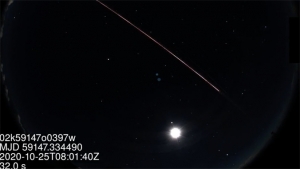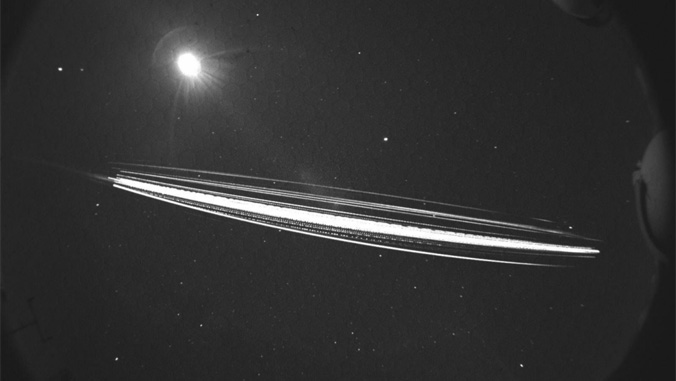Thousands were mesmerized by a mysterious flurry of lights that appeared to float across Hawaiʻi’s evening sky on Saturday, October 24. Photos and videos of the string of lights flooded social media, leaving many to believe the sighting could be anything from a spaceship carrying extra terrestrials to a meteor shower.
University of Hawaiʻi at Mānoa Institute for Astronomy Professor Richard Wainscoat believes onlookers witnessed the reentry of a spent rocket booster used to launch Venezualan satellite, Venesat-1, back in 2008. The used rocket has been circling Earth since the launch, slowly losing altitude due to friction with the tenuous atmosphere in low-Earth orbit. On Saturday, the booster made its final orbits.

Wainscoat works with the Pan-STARRS telescope on Haleakalā, and said the reentry was predicted to occur over the Atlantic Ocean at 7:24 p.m. HST on October 24. He added that the object stayed in orbit a little longer than expected, and finally burned up in the atmosphere over Hawaiʻi, an occurrence that does not happen very often.
“Seeing a reentry is relatively rare for a specific location like Hawaiʻi, since we can only see the reentry if it occurs relatively close to us,” Wainscoat explained. Reentries are a common occurrence, with typically one to two per week taking place somewhere around the Earth. According to Wainscoat, although it’s possible for large solid pieces to survive reentry, most of the object will burn up, and any surviving debris will usually fall in the ocean or in uninhabited locations.
The reentry was also spotted by many of the sky-monitoring cameras at the Maunakea and Haleakalā observatories. The Canada-France-Hawaiʻi Telescope cloud camera on Maunakea captured an image of the streaking debris, as did the all-sky monitor on the ATLAS telescope on Haleakalā. AMOS systems on Haleakalā and Maunakea captured the rocket re-entry, as well. The observations by AMOS are used for observations and analysis of meteors and fireballs to help astronomers understand the structure of the solar system.
- More news from the Institute for Astronomy:
- Water across Moon’s sunlit surface discovered by UH scientists, October 27, 2020
- Massive asteroid subject of new findings, October 26, 2020
Tracking asteroids
Telescopes on Haleakalā and Maunakea also play a critical role in tracking potentially hazardous asteroids and assist with rapid follow-up observations to verify an asteroid’s orbit and if it poses any threat to Earth.


